New
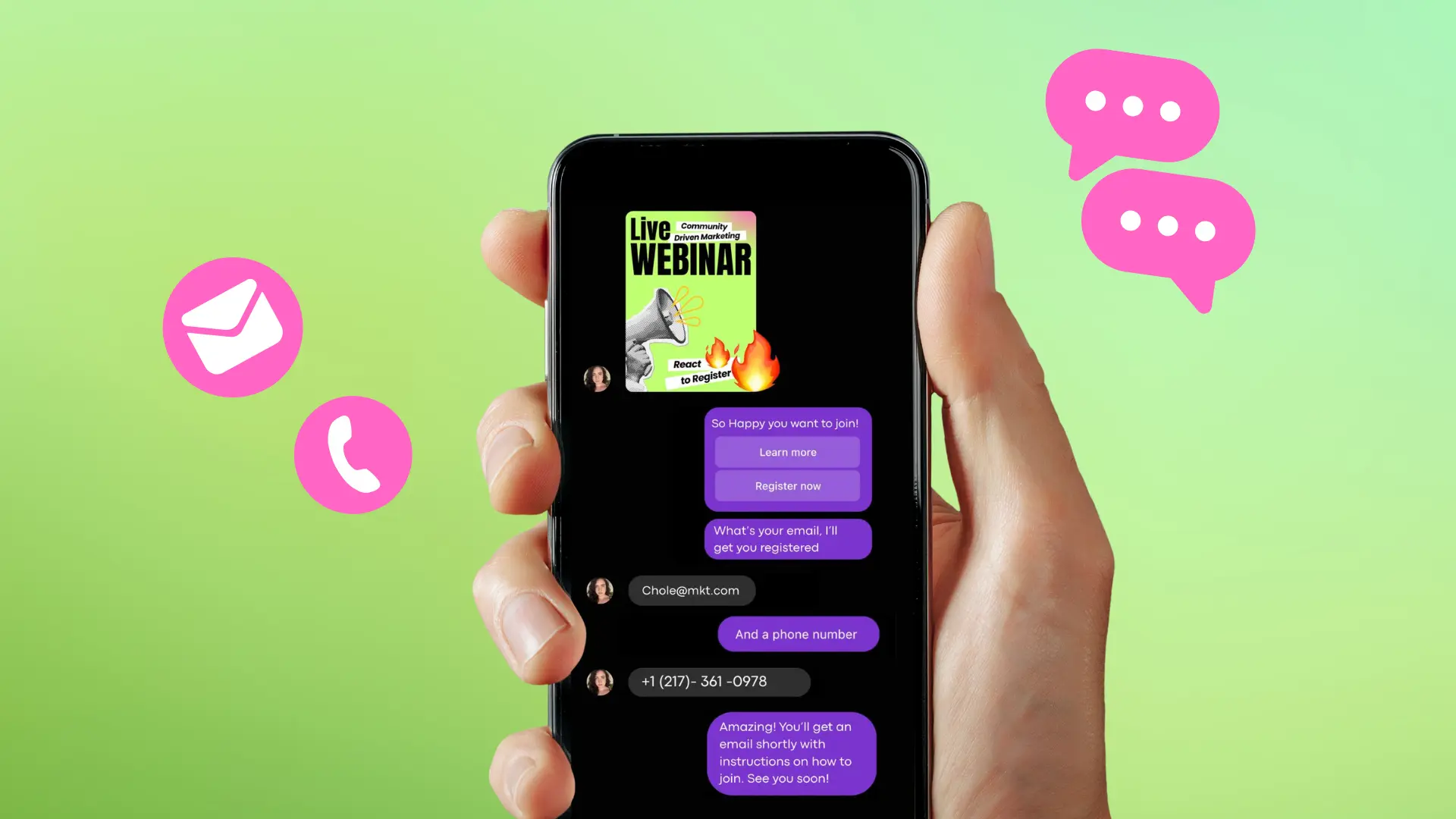
Turn Your DMs Into Lead Gen!
Learn how to collect lead data from your DMs such as email addresses, phone numbers, and more right from your social inbox. If you are not yet automating your DMs your competitors are outpacing you.

How Something Social Saved 75% of Their Time and Increased Revenue by 15%
See how a fast-growing agency improved operations, cut down hours of manual work, and unlocked new revenue opportunities with Vista Social.
New
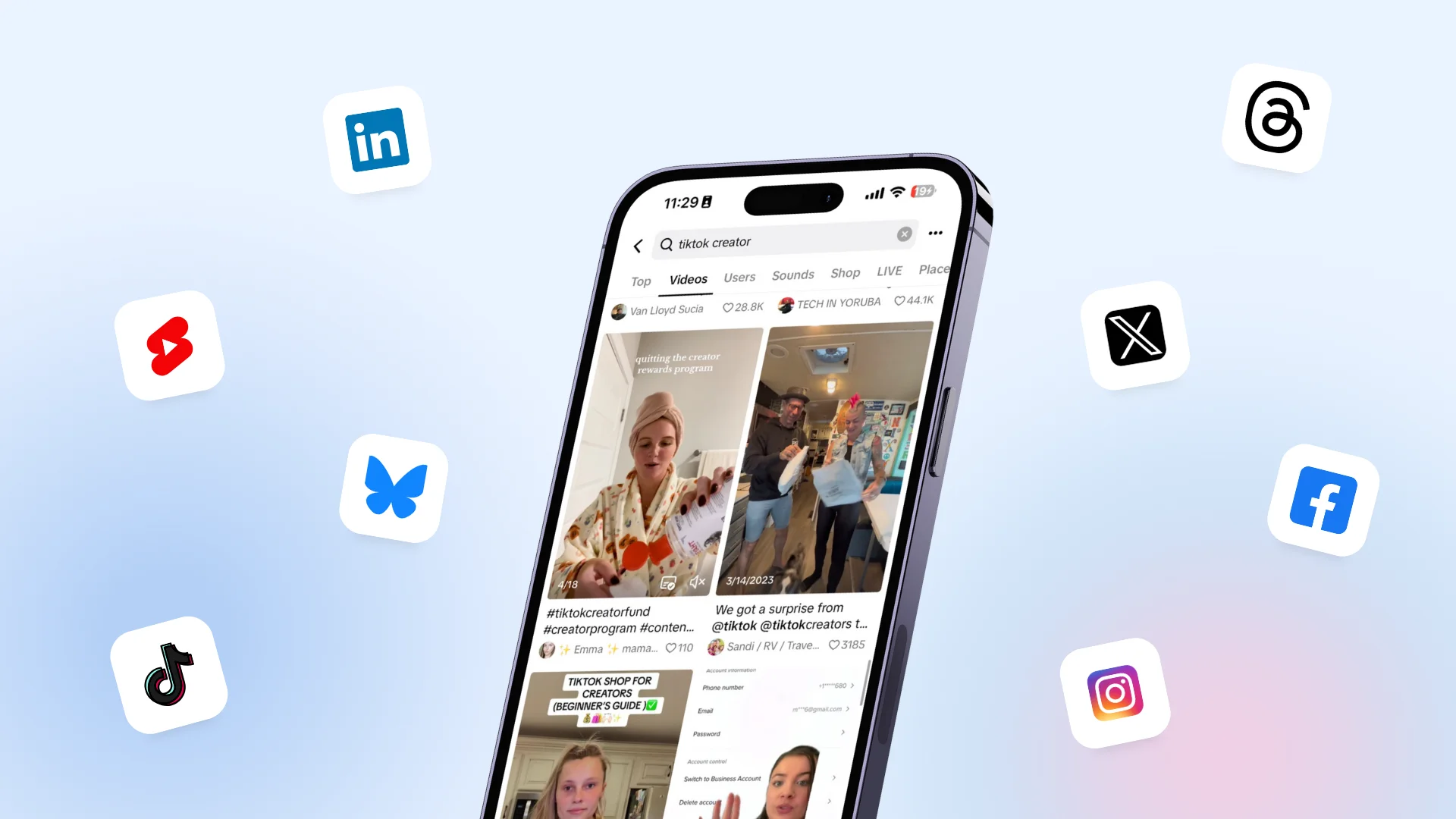
50 Unique Social Media Ideas for Consistent Content Creation
Discover 50 unique social media post ideas to engage your audience, grow your brand, and maintain a consistent content strategy with ease!
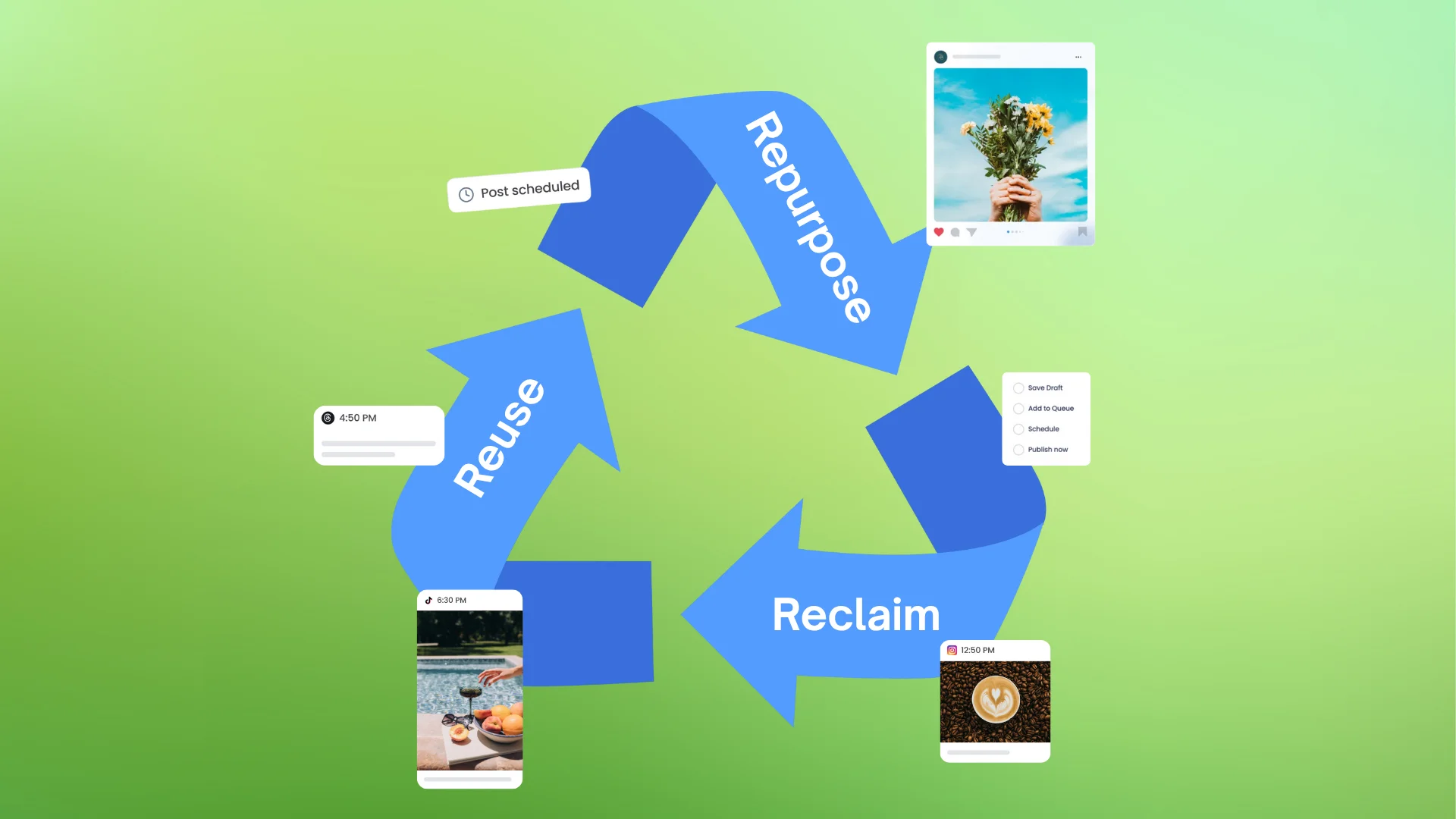
Mastering Content Reuse: The Key to a Consistent and Sustainable Posting Strategy
Published on April 22, 2025
13 min to read
B2B Employee Advocacy Step-by-Step Guide in 2025
Summarize with AI
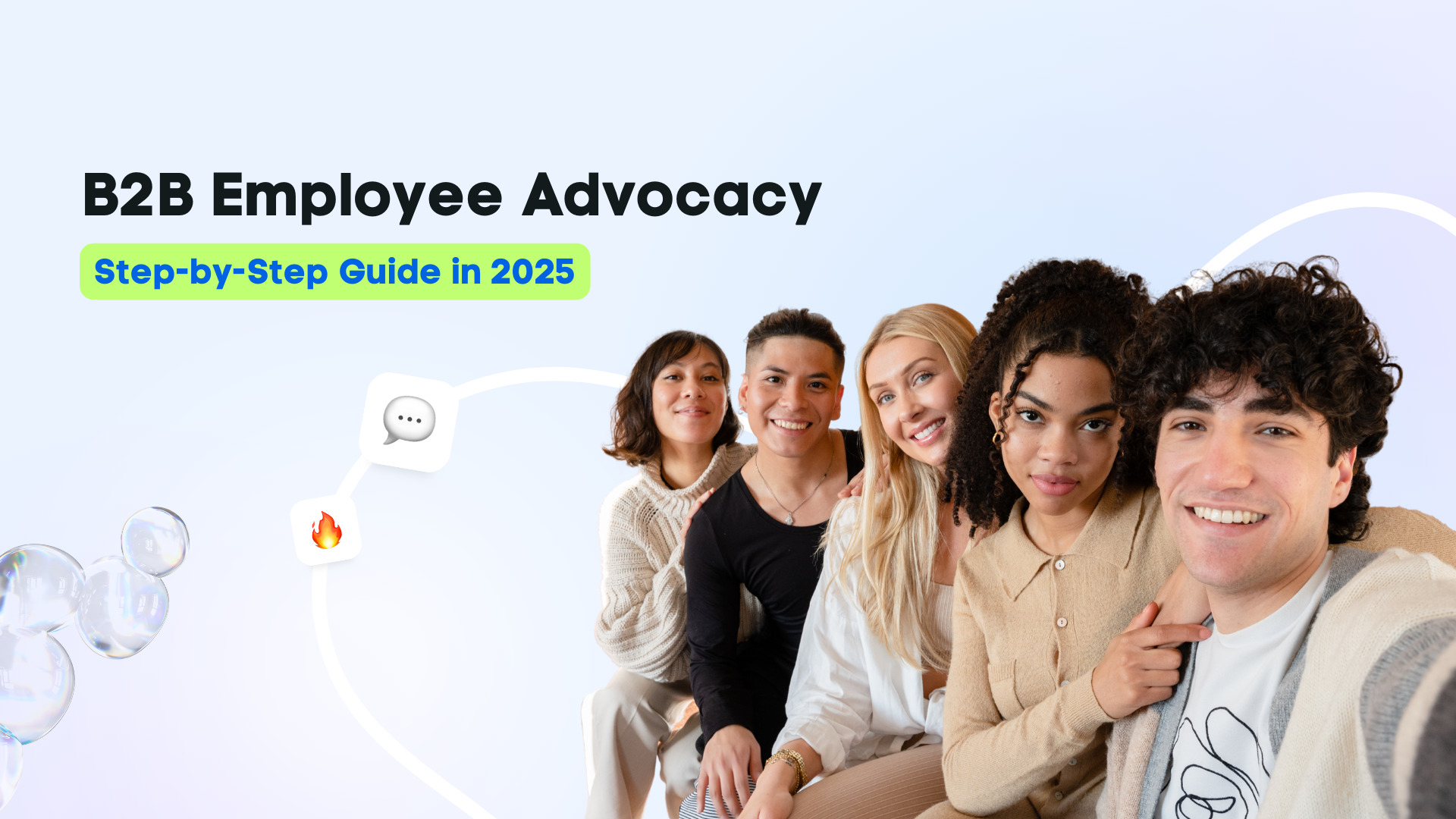

Table of Content

Your B2B employee advocacy campaigns can take your social media and online marketing game to the next level.
After all, employees promoting your brand isn’t just word of mouth—it’s trusted and authentic.
It’s also way more relatable than a corporate post with stock photos and stiff language.
The question is, where do you start?
And how do you get your employees on board without adding extra work?
You can turn your team into your biggest B2B marketing win with a simple plan and the right tools.
This guide walks you through each step to build, launch, and grow a B2B employee advocacy program that actually works.
Let’s dive in.
Table of contents
What you will learn
- What is B2B employee advocacy?
- What are the benefits of B2B employee advocacy?
- What to consider before running a B2B employee advocacy program
- How to run a B2B employee advocacy program with Vista Social
- Top 10 B2B Employee advocacy content ideas to boost lead generation
- FAQs on B2B employee advocacy
- Make B2B employee advocacy your power move in 2025
What is B2B employee advocacy?
B2B employee advocacy is when your employees actively promote and share your company’s values, brand message, and content on their personal social media accounts.
B2B advocacy posts are commonly shared across social media platforms such as LinkedIn, where B2B conversations thrive.
Instead of relying only on your official company pages, employee advocacy taps into your team’s internal network.
Must read: What is The Future of Employee Advocacy?
It helps you reach a wider (and often more engaged) audience, humanize your brand, and build trust with followers and potential clients.
Think of B2B employee advocacy like this: People trust people more than logos.
When your employee advocate shares a company win, new product update, or helpful industry tip, it feels more authentic and gains more traction.
B2B employee advocacy can be low-cost, high-impact marketing, powered by your people.
What are the benefits of B2B employee advocacy?
Running an employee advocacy program or campaign for your B2B provides the following perks.
Must read: Top Benefits of Employee Advocacy: w/ Tips
Massive boost in brand visibility
Employees sharing your company’s content on LinkedIn and other social media platforms allow you to tap into their networks while reaching your brand’s followers.
That’s a lot of extra eyeballs on your brand.
Data backs this up, showing that posts by employees typically get 561% more reach than those shared by brand accounts.
The more attention your brand receives, the more opportunities you have to boost engagement and conversions.
Authenticity that builds trust
The truth is that people trust people more than they trust brands.
Employee advocacy adds a touch of authenticity that polished brand posts can’t replicate.
Your sales rep sharing a product update or a team member posting behind-the-scenes content resonates more on a human level.
Thought leadership at scale
Leveraging the power of employee advocacy equips your employees to share opinions, insights, or curated industry content, positioning them as thought leaders.
By extension, it also positions your brand as credible and a source of reliable information.
Employee advocacy can also help with recruiting, as showcasing your company as a place filled with smart professionals can attract top talent.
Stronger lead generation
Content shared by employees tends to drive more meaningful traffic.
Why? Because it feels less like a sales pitch and more like a recommendation.
When your brand’s account posts your latest product or service, it’s often seen as promotional (because, well, it is).
However, an employee sharing the same content can seem more authentic and trustworthy to the audience.
It’s like getting a tip from someone “on the inside,” rather than being sold to by a brand, which helps drive conversions.
Improved employee engagement
Employees who participate in advocacy programs can feel a stronger connection to your brand.
After all, employee advocacy gives them a voice, a purpose, and a reason to feel proud of your company’s mission.
Essentially, advocacy can motivate your employees to become advocates because they believe in your brand.
It can boost employee engagement and amplify your advocacy efforts. Using employee engagement software can help further enhance this by providing tools to track, measure, and encourage employee involvement.
Cost effective content distribution
Let’s be real: paid ads are great, but they’re not always cheap.
Your employee advocacy efforts play a crucial role in amplifying your brand.
It allows you to distribute content organically via the people who already believe in your brand.
What to consider before running a B2B employee advocacy program
Before launching a B2B employee advocacy program, laying the groundwork to set your team and brand up for success is essential.
Consider the following.
Clear goals and KPIs
The first thing you should do before launching your B2B employee advocacy program is to determine WHY you’re launching it.
Do you want your advocacy program to boost your brand’s visibility, drive traffic to your site, position your team as thought leaders, or attract top-tier talent?
Whatever your goals, identify them upfront and tie them to measurable Key Performance Indicators (KPIs).
Doing so guides your strategy and helps you prove ROI later on.
Consider key metrics such as reach, shares, click-through rates, or leads driven by employee posts.
Executive buy in
If leadership isn’t on board, employee advocacy for your B2B company can be a tough sell.
After all, advocacy programs thrive when your executives are involved, not just as supporters, but as participants.
Employees are more likely to follow suit when leaders share your company’s content and cheer on the initiative.
It sends a clear message: this isn’t just a marketing experiment, but a company-wide priority.
Must read: Employee Advocacy Marketing: Tips And Tricks this 2024
Employee willingness and fit
Not every employee wants to be active on social media, and that’s totally fine.
The key is to identify team members who are already active online or show interest in building their personal brand.
These natural advocates are often your best early adopters.
Start with a small, enthusiastic group to pilot your employee advocacy program and work out any kinks.
Must read: 3 Employee Advocacy Program Examples worth Following
Once you’ve got a system that works, you can scale it out to more employees.
Content strategy and consistency
You can’t expect employees to share if there’s nothing valuable to post.
Ensure you have a steady stream of engaging advocacy and social media content.
Your advocacy-related posts can include educational team wins, blog posts, product updates, industry insights, or even behind-the-scenes content.
Remember to add some variety to keep your content fresh.
Consider creating a central hub where employees can find pre-approved posts with suggested captions to streamline your content strategy development and publishing process.
Must read: Key Employee Advocacy Strategy That Boosts Brand Visibility
Training and enablement
Even if your team is social media-savvy, don’t assume they know how to advocate for your brand effectively.
Offer training sessions that cover basic employee advocacy, such as optimizing LinkedIn profiles, understanding your brand’s tone, and crafting compelling captions.
Give your employee advocates the tools they need, including content templates, example posts, quick guides, or even convert training manuals to video to make learning faster and more engaging.
Must read: Top Employee Advocacy Guide: w/ Tips, Tools, & Programs
The easier you make it for employees to implement advocacy, the more likely they are to participate.
Tools and tech stack
Managing advocacy manually?
That’s going to get messy fast.
Instead of manual methods, use an employee advocacy platform.
The tools let you curate shareable content, monitor and analyze engagement, and simplify the whole process for your team.
Must read: Top Employee Advocacy Tools to Improve Brand Reach this 2025
Many employee advocacy platforms even offer analytics, so you can measure what’s working and what needs improvement.
Brand and compliance guidelines
To protect your brand (and your employees), establish clear rules for what to share and what not to post.
Create a simple and friendly guide that covers tone, messaging, and relevant compliance or legal issues.
Must read: Employee Advocacy Guidelines Worth Following This 2024
The goal is to empower your team, not scare them away or restrict them too much with overly strict policies.
Incentives and recognition
People like to be appreciated, especially employees, and a little recognition goes a long way.
Celebrate your top employee advocates with internal shoutouts, social recognition, or small perks such as company swag or gift cards.
You could even gamify the program with a leaderboard or monthly “MVP” award. It doesn’t have to be fancy—just meaningful.
Recognizing your advocates’ efforts and providing incentives is an excellent way to motivate them and reward their contribution to your program and company.
How to run a B2B employee advocacy program with Vista Social
A successful employee advocacy program turns your team into social media ambassadors, helping expand your brand’s reach, build trust, and generate leads.
With Vista Social, you can streamline implementing your advocacy programs.
The social media management platform offers essential features to help with everything from content creation to employee sharing while maintaining brand consistency and compliance.
The step-by-step guide below walks you through running your program via Vista Social’s Employee Advocacy feature.
Step 1: Set up employee advocacy in Vista Social
After logging into Vista Social and connecting your profiles, such as LinkedIn, click Advocacy in the left-hand sidebar.
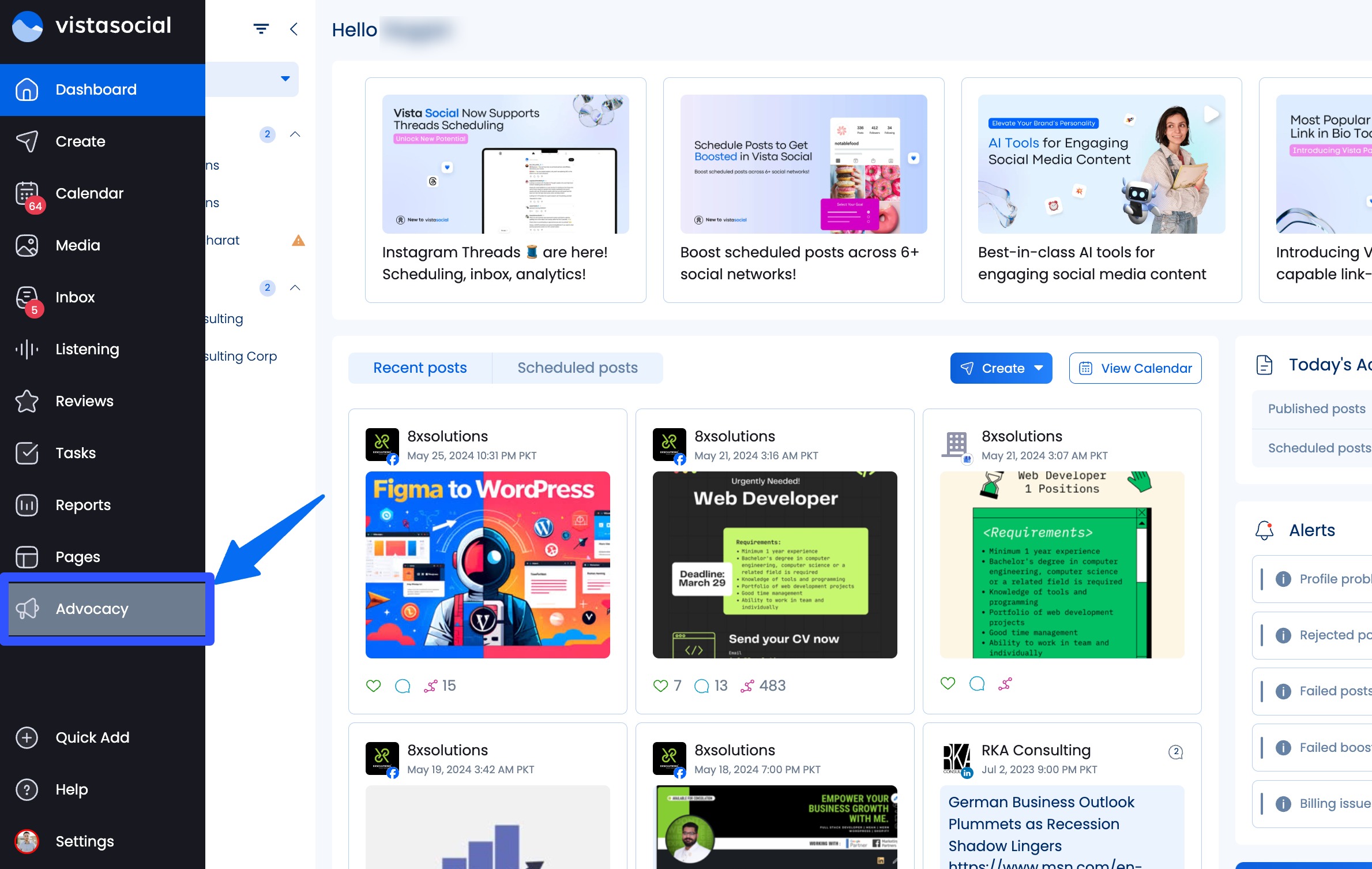
Click + Create advocacy in the top right corner of the Employee Advocacy page.
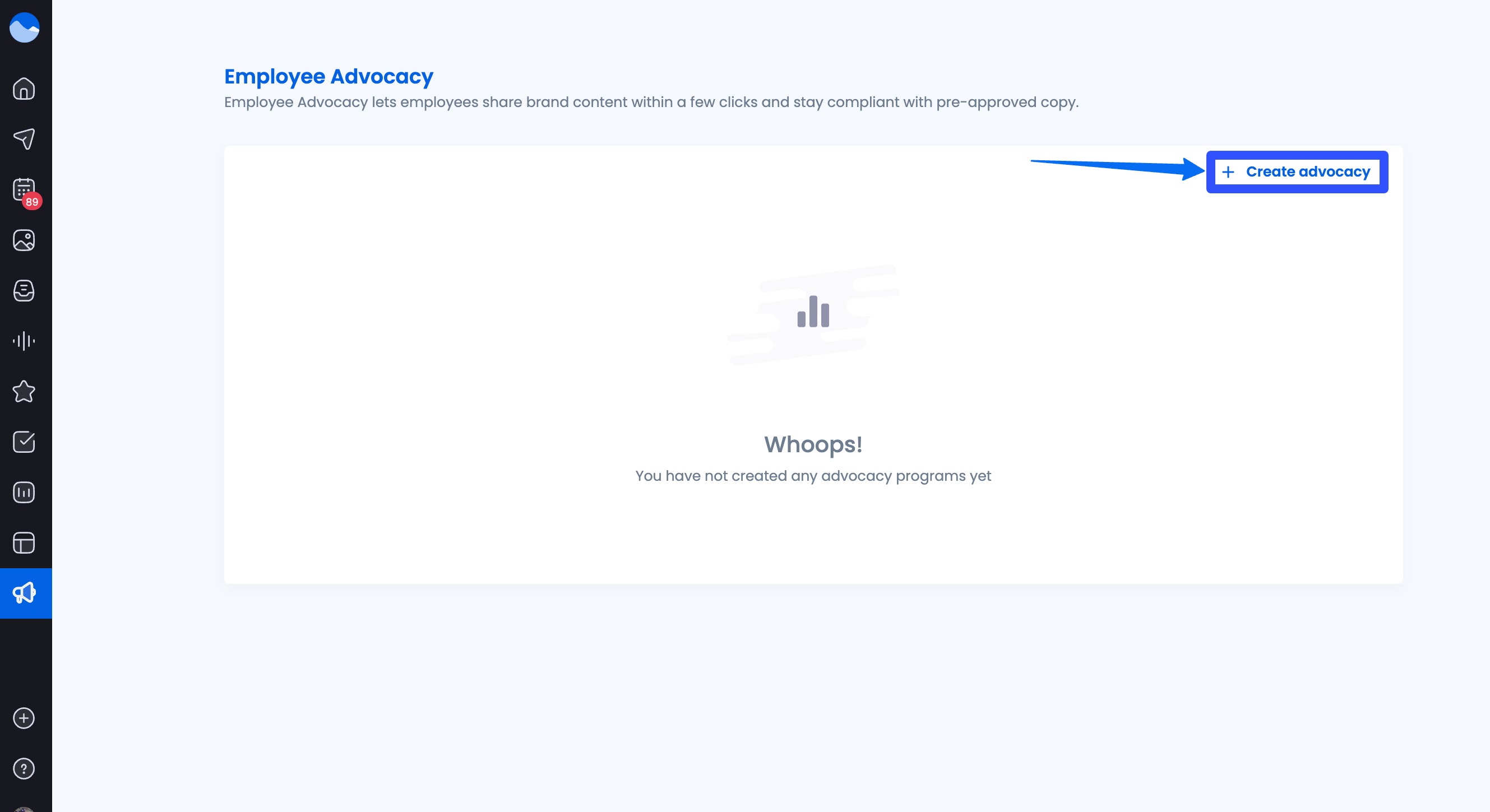
Note: Vista Social allows only one advocacy per profile group.
Next, select the profile group for which you want to create your advocacy and provide or set the required details, such as:
- Slack notifications
- Email notifications
- Email digests
- Suggestion notifications
- Earned media value
- Campaign tracking via UTM parameters
Try Vista Social for Free
A social media management platform that actually helps you grow with easy-to-use content planning, scheduling, engagement and analytics tools.
Get Started NowMust read: How to Simplify Implementing Employee Advocacy Campaigns

Step 2: Invite your advocates
Add the employees you’d like to participate in the program by clicking the + Invite advocates option.

Note: Advocates only get access to the Employee Advocacy hub (not your full Vista Social workspace).
You can either import a CSV file containing your employees’ first and last names and email addresses or invite them individually by entering them in the designated fields.
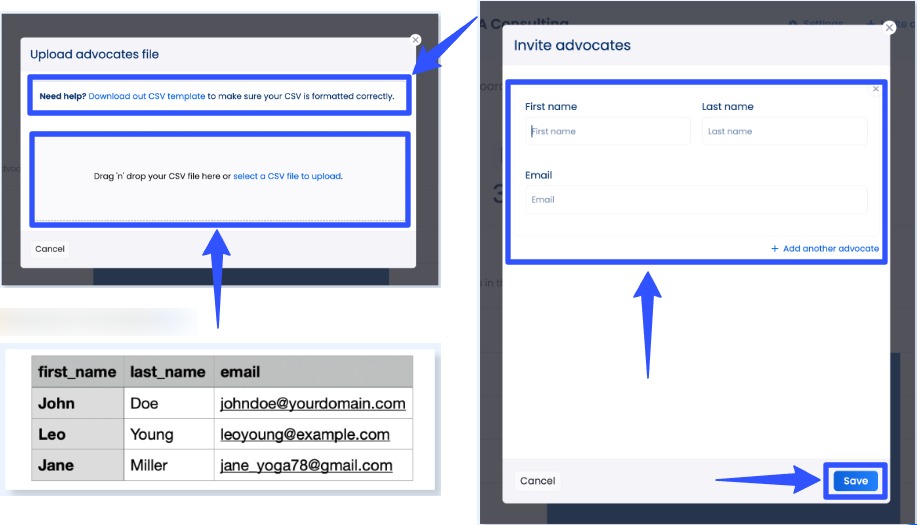
Click Save, and you’re all set.
The next step is to create your employee advocacy content.
Step 3: Create and curate shareable content
Vista Social lets you create two types of advocacy content.
The Advocacy content or posts are those that you or your admins create and make available for employees to share on their social media pages as new organic posts.
For instance, your employees can publish or schedule your advocacy post on their LinkedIn personal profiles.
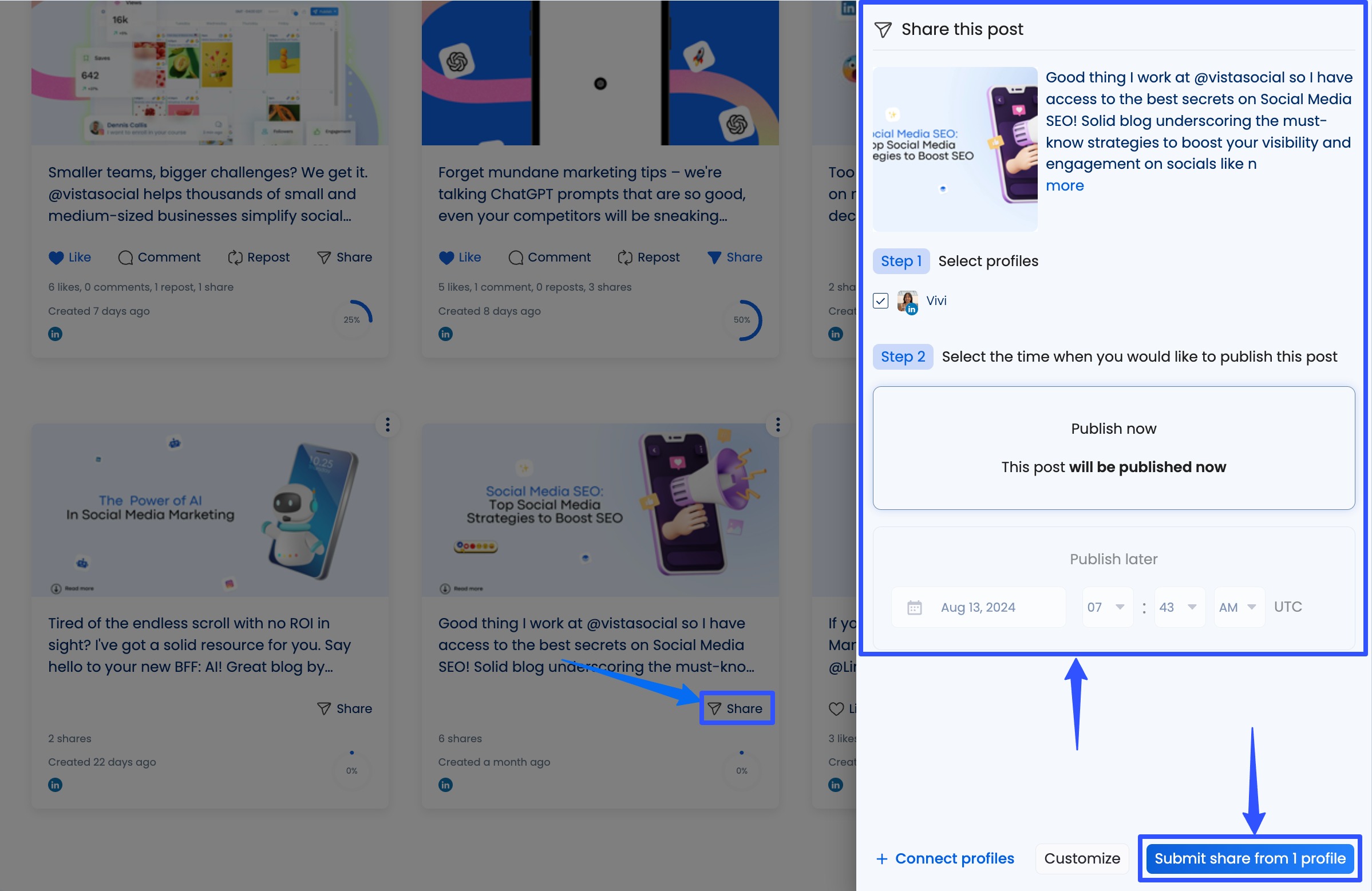
Another type of advocacy content on Vista Social is posts that were previously published to your company’s social media accounts.
You can set the posts to be available for your employees to interact with, such as commenting, liking, sharing, and reposting.
To create an advocacy post, go to the Advocacy page and click the Schedule advocacy post button in the top right corner.
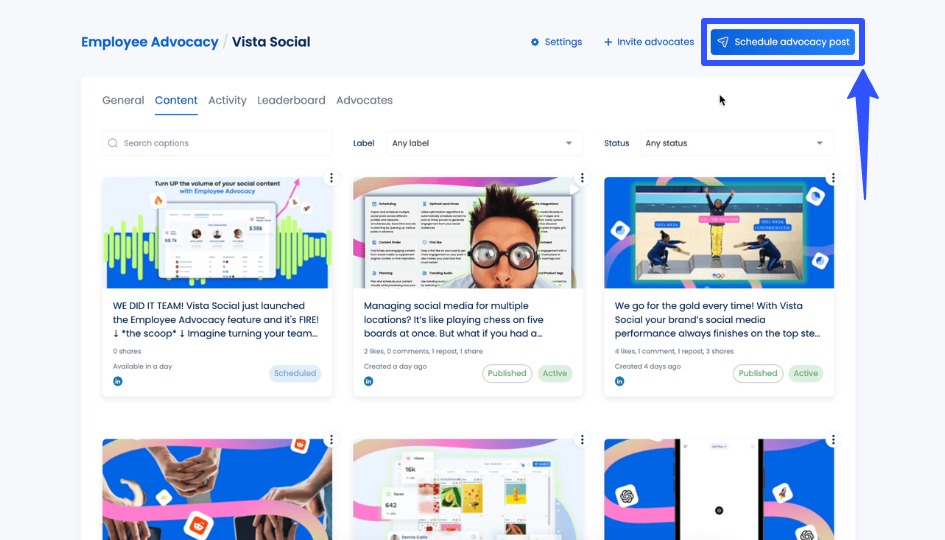
Then, select the advocacy post type.
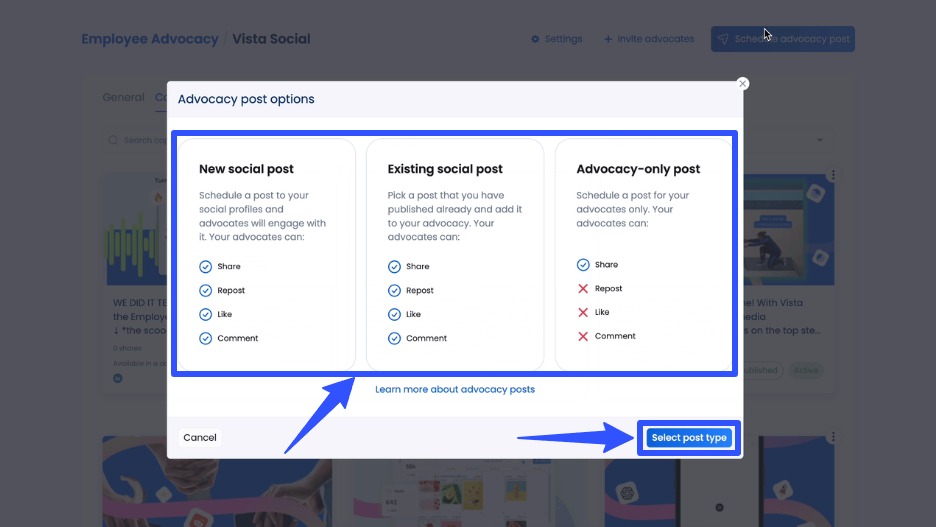
Create and customize your post and do the following:
- Select the specific profiles where you want to publish the post
- Add a caption or description, including hashtags, links, emojis, and more
- Use the AI Assistant to generate or refine your post’s description and taglines instantly
- Upload an image or video
- Set the post to auto-publish on a schedule
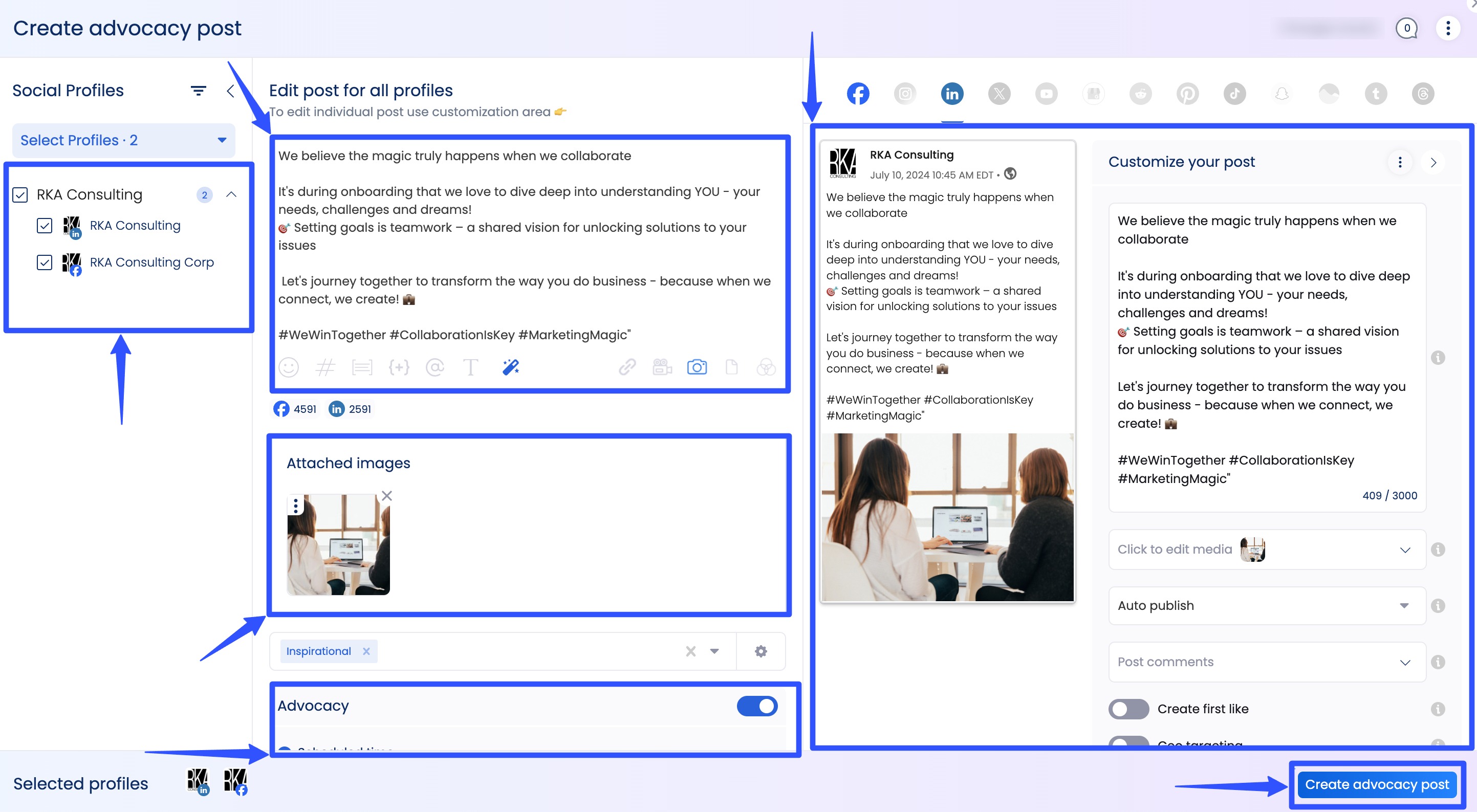
You can switch the Advocacy toggle button on or off and set a schedule for the post to be made available to your employee advocates.
You can also save the post as a draft if it needs further revisions or approval.
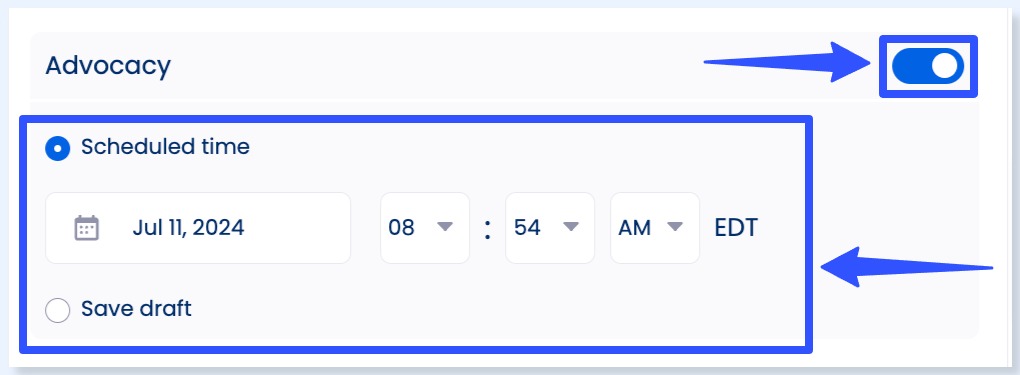
You can also schedule a post via Vista Social’s social media publishing feature and turn it into an advocacy post by switching on the Add to advocacy option.
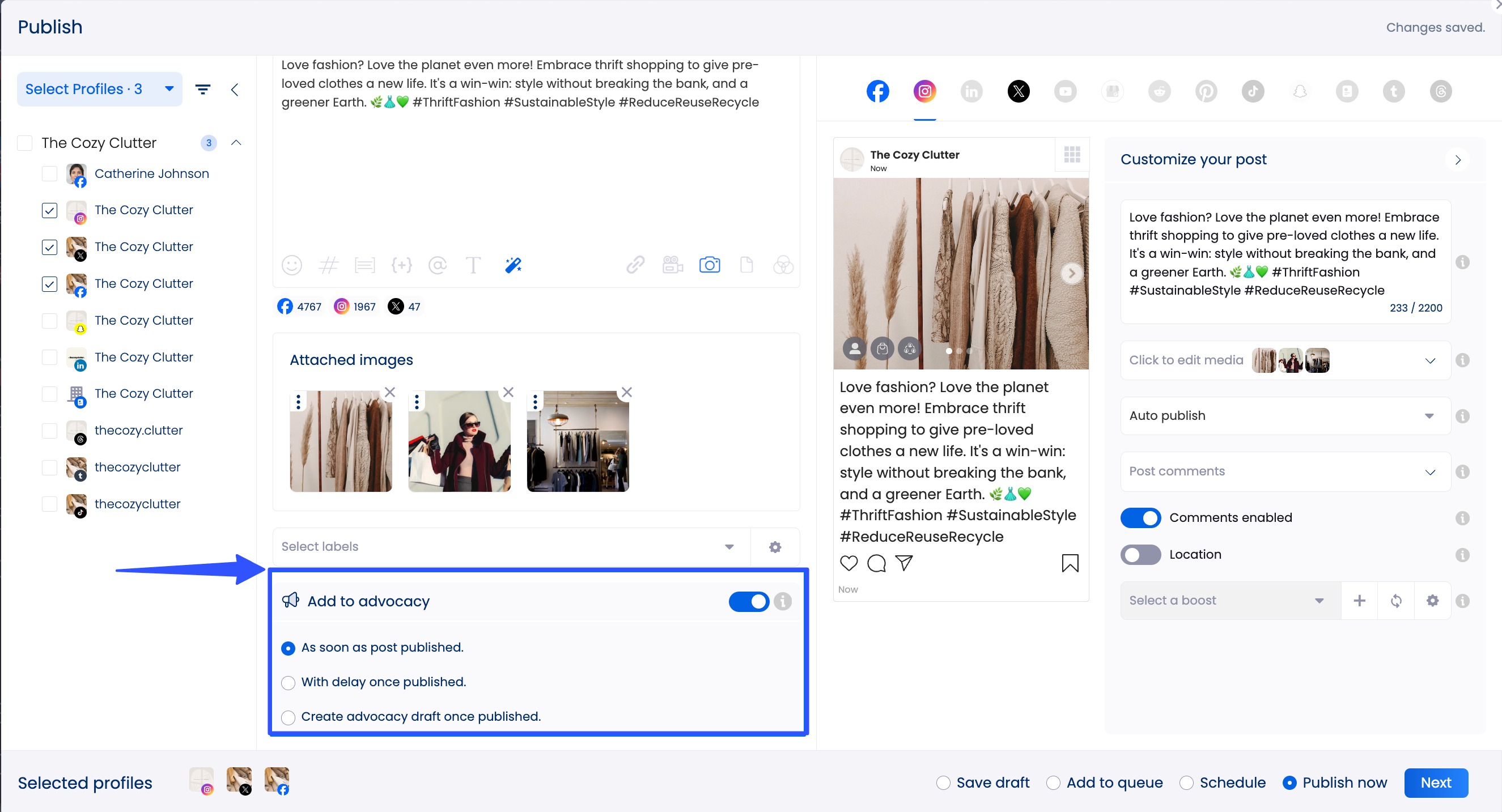
You can choose to add the post to your advocacy content:
- As soon as the post is published
- With a delay once published
- To create a draft once the post is published
Consider creating employee advocacy post variations.
This way, your employees have options when sharing, which helps reduce duplicate posts and boosts authenticity.
Step 4: Manage your employee advocacy dashboard
Now that you have advocates and advocacy posts, it’s time to manage everything from your Vista Social Employee Advocacy dashboard.
The main dashboard shows your list of B2B brands and businesses currently running an advocacy program.

Click on one to access another dashboard specific to your employee advocacy program.
The General section gives a quick view of your advocates, shares, posts, reposts, likes, comments, reach, and Earned Media Value (EMV).

The data helps you track how your employee advocacy program is performing right, and you can:
- See which posts get the most shares, clicks, and impressions
- Monitor your top advocates
- Identify high-performing content types to replicate success
Click on the Content, Activity, Leaderboard, and Advocates tabs to view each section.

Top 10 B2B Employee advocacy content ideas to boost lead generation
Give your employee advocacy marketing efforts a better chance at succeeding with the creative and strategic content ideas below.
1. Behind-the-scenes sneak peeks
Give your prospective clients a look inside your company, including how your team works, collaborates, or celebrates wins.
For instance, you can share an employee advocacy video on LinkedIn that shows how your team prepped for last week’s big product rollout.
Your advocates can use a “Proud to be part of a crew that makes things happen! 💥” caption for the post.
Why it works: The post can add authenticity, build your brand’s personality, and spark curiosity among potential clients.
2. Customer wins or success stories
Encourage employees to share case studies or testimonials about your brand, but allow them to add a personal touch.
For example, your advocates can post about “Exciting to see [Client Name] scale their sales pipeline 40% using our platform. Real results from real people. 🙌”
Why it works: The content and caption help showcase your product’s value through social proof, which is what many B2B buyers want to hear to hit that “Buy” button.
3. Thought leadership commentary
Let your employees share their thoughts on industry-relevant news, trends, or challenges that your solution helps address.
For example, if you provide a content scheduling tool that leverages AI uniquely, create an engaging caption like this:
“AI is transforming marketing—but without the right tools, it’s just noise. Here’s what we’re doing differently.”
Why it works: The content positions your team as knowledgeable insiders, attracting buyers looking for trusted solutions.
4. Product tips and mini tutorials
Educate and promote your products at the same time by having your employee advocates share quick hacks, how-tos, or cool features about your product.
Here’s a sample post caption:
“Did you know you can schedule cross-platform posts in two clicks with Vista Social? Here’s how I save an hour every Monday. #WorkSmart”
Why it works: The content helps educate potential leads, builds interest, and drives trial or demo requests.
5. Event or webinar invitations
Boost attendance for your brand’s lead-generation events by having your employees share personalized invites on their social media pages.
For instance, your advocates can promote your online event using this caption:
“I’m hosting a free LinkedIn strategy session this Thursday with our Vista Social crew. Join us if you want more engagement (and less guesswork). 🚀”
Why it works: Warm invites from familiar faces can lead to higher registration and better-quality leads.
6. Company updates or milestones
Turn your company’s internal wins into shareable moments, such as funding rounds, partnerships, or product launches.
Suppose your company on social media launches a new product feature.
Your advocates can create LinkedIn posts such as:
“We just launched our most requested feature! Proud of the team for making this happen. Check it out 👉 [link here]”
Why it works: Sharing company achievements helps keep your brand top of mind, especially among prospects already considering your app or solution.
7. Day in the Life employee spotlights
Humanize your brand by sharing advocacy content that shows what it’s like working at your company.
For example, your employee advocate can post about a day in their life with this caption:
“Started my day reviewing campaign insights on Vista Social, ended it with virtual tacos 🌮 with the team. #RemoteLife”
Why it works: The post can help build trust, showcase your company’s culture, and make your brand more relatable, especially in long sales cycles.
8. FAQ style problem solving posts
Create employee advocacy content that answers the real questions your potential clients are searching for on Google.
For example, your advocates can highlight the specific pain point your product solves in their post, like this:
“Struggling with social scheduling across multiple clients? Here’s how I streamline everything in 15 mins using our platform.”
Why it works: The post helps potential clients proactively address their pain points by presenting your product as the go-to solution.
9. Lead magnets and free resources
Encourage employees to share valuable, gated content with tracking links, such as eBooks, templates, or checklists.
For instance, you can have your advocates share a post highlighting your comprehensive social media audit checklist.
You can use this post caption:
“We just published a free checklist for social media audits. Grab it here if you’re revamping your 2025 strategy! 📋👇”
Why it works: The post can drive qualified leads into your funnel while offering real value upfront.
10. User-generated content and testimonials
Share advocacy posts that your employees can share to amplify what your customers are saying.
For instance, your advocates can share a simple post praising a specific customer for providing feedback.
“Shoutout to [Customer] for this awesome feedback! Love seeing our platform in action 💙 #CustomerLove”
Why it works: The advocacy post combines authenticity with social proof, further nudging leads down your sales funnel.
FAQs on B2B employee advocacy
How does B2B employee advocacy help you generate leads?
Employee-shared content can reach untapped networks, driving more qualified traffic to your website.
These leads are typically warmer since they’ve likely been introduced to your brand through a trusted source.
It can result in shorter sales cycles and higher conversion rates.
Which platforms are most effective for B2B employee advocacy?
LinkedIn is often the premier platform for B2B advocacy due to its professional focus.
However, platforms like X (formerly Twitter) and industry-specific forums can also be effective, depending on where your target audience is most active and your advocacy plan.
Must read: How to Build an Employee Advocacy Plan: Step-by-Step Guide
How do you measure the success of your employee advocacy program?
An effective method is to track and analyze key metrics, such as:
- Engagement rates on employee-shared content
- Website traffic increases from social referrals
- The number of leads generated via your advocacy efforts
- Growth in your reach and brand awareness
Make B2B employee advocacy your power move in 2025
B2B employee advocacy can be a high-impact strategy that supercharges your brand reach.
It can also help your brand build trust with potential clients on a larger scale and generate qualified leads.
The key is to develop or follow a step-by-step game plan to turn your employees into a powerhouse of influence on LinkedIn and other relevant social networks.
Make employee advocacy easy and effective with Vista Social.
The social media management platform gives your team the tools to create, schedule, and share content that drives results.
About the Author
Content Writer
Jimmy Rodela is a social media and content marketing consultant with over 9 years of experience, with work appearing on sites such as Business.com, Yahoo, SEMRush, and SearchEnginePeople. He specializes in social media, content marketing, SaaS, small business strategy, marketing automation, and content development.
Read with AI
Save time reading this article using your favorite AI tool
Summarize with AI
Never Miss a Trend
Our newsletter is packed with the hottest posts and latest news in social media.
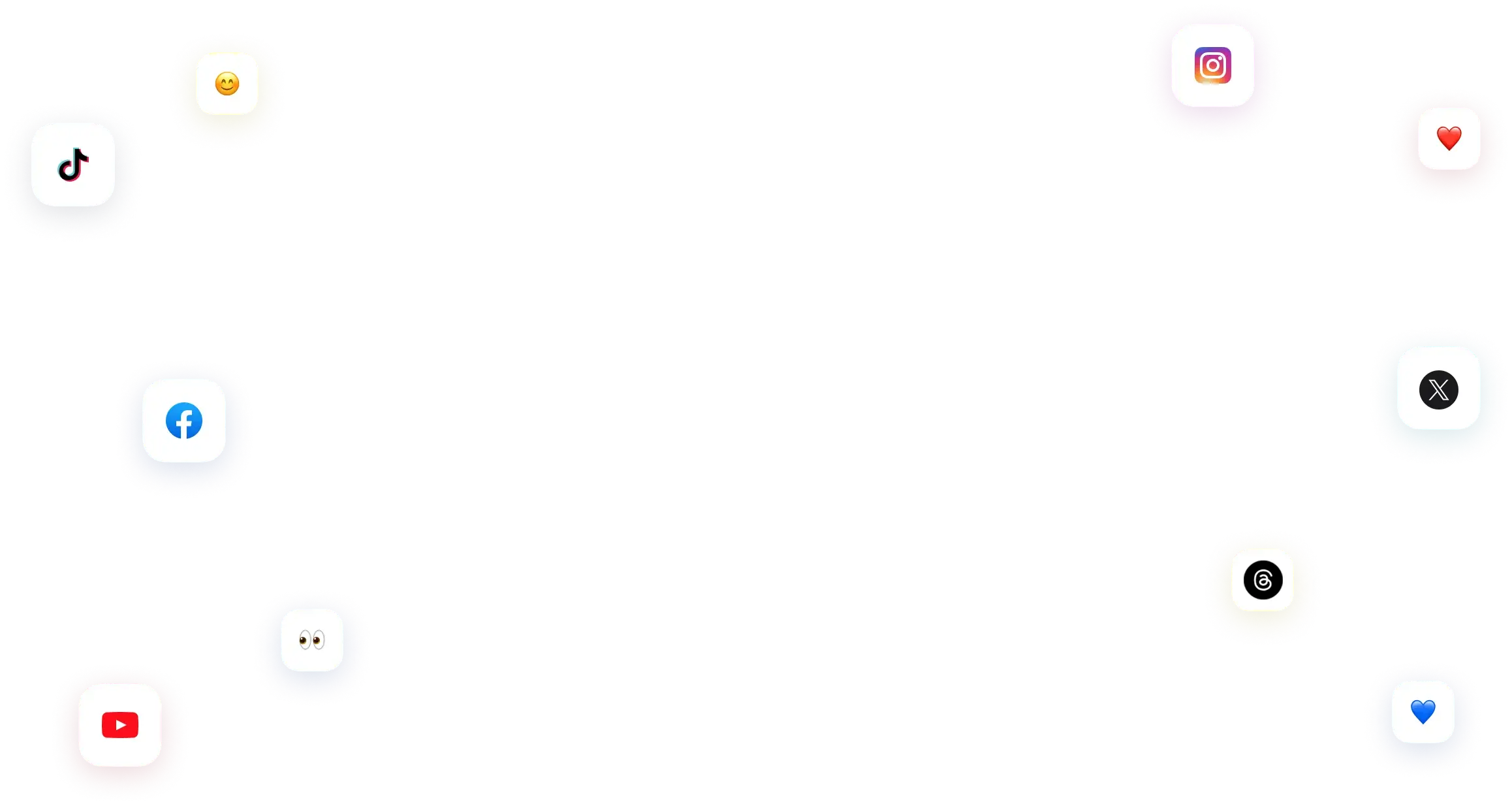
You have many things to do.
Let us help you with social media.
Use our free plan to build momentum for your social media presence.
Or skip ahead and try our paid plan to scale your social media efforts.
P.S. It will be a piece of cake 🍰 with Vista Social
Subscribe to our Newsletter!
To stay updated on the latest and greatest Social Media news. We promise not to spam you!


